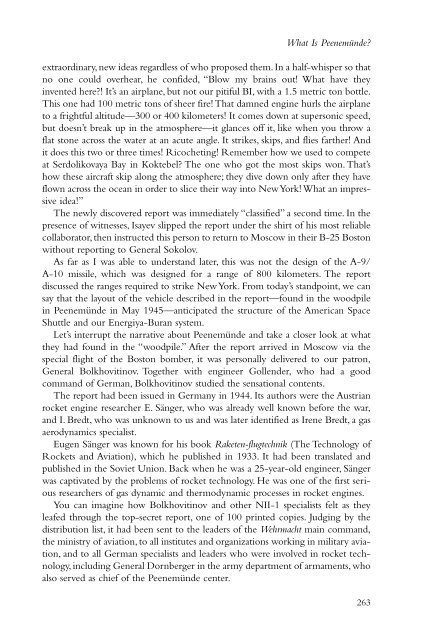to open next chapter. - NASA's History Office
to open next chapter. - NASA's History Office
to open next chapter. - NASA's History Office
You also want an ePaper? Increase the reach of your titles
YUMPU automatically turns print PDFs into web optimized ePapers that Google loves.
What Is Peenemünde?<br />
extraordinary, new ideas regardless of who proposed them. In a half-whisper so that<br />
no one could overhear, he confided, “Blow my brains out! What have they<br />
invented here?! It’s an airplane, but not our pitiful BI, with a 1.5 metric <strong>to</strong>n bottle.<br />
This one had 100 metric <strong>to</strong>ns of sheer fire! That damned engine hurls the airplane<br />
<strong>to</strong> a frightful altitude—300 or 400 kilometers! It comes down at supersonic speed,<br />
but doesn’t break up in the atmosphere—it glances off it, like when you throw a<br />
flat s<strong>to</strong>ne across the water at an acute angle. It strikes, skips, and flies farther! And<br />
it does this two or three times! Ricocheting! Remember how we used <strong>to</strong> compete<br />
at Serdolikovaya Bay in Koktebel? The one who got the most skips won. That’s<br />
how these aircraft skip along the atmosphere; they dive down only after they have<br />
flown across the ocean in order <strong>to</strong> slice their way in<strong>to</strong> New York! What an impressive<br />
idea!”<br />
The newly discovered report was immediately “classified” a second time. In the<br />
presence of witnesses, Isayev slipped the report under the shirt of his most reliable<br />
collabora<strong>to</strong>r, then instructed this person <strong>to</strong> return <strong>to</strong> Moscow in their B-25 Bos<strong>to</strong>n<br />
without reporting <strong>to</strong> General Sokolov.<br />
As far as I was able <strong>to</strong> understand later, this was not the design of the A-9/<br />
A-10 missile, which was designed for a range of 800 kilometers. The report<br />
discussed the ranges required <strong>to</strong> strike New York. From <strong>to</strong>day’s standpoint, we can<br />
say that the layout of the vehicle described in the report—found in the woodpile<br />
in Peenemünde in May 1945—anticipated the structure of the American Space<br />
Shuttle and our Energiya-Buran system.<br />
Let’s interrupt the narrative about Peenemünde and take a closer look at what<br />
they had found in the “woodpile.” After the report arrived in Moscow via the<br />
special flight of the Bos<strong>to</strong>n bomber, it was personally delivered <strong>to</strong> our patron,<br />
General Bolkhovitinov. Together with engineer Gollender, who had a good<br />
command of German, Bolkhovitinov studied the sensational contents.<br />
The report had been issued in Germany in 1944. Its authors were the Austrian<br />
rocket engine researcher E. Sänger, who was already well known before the war,<br />
and I. Bredt, who was unknown <strong>to</strong> us and was later identified as Irene Bredt, a gas<br />
aerodynamics specialist.<br />
Eugen Sänger was known for his book Raketen-flugtechnik (The Technology of<br />
Rockets and Aviation), which he published in 1933. It had been translated and<br />
published in the Soviet Union. Back when he was a 25-year-old engineer, Sänger<br />
was captivated by the problems of rocket technology. He was one of the first serious<br />
researchers of gas dynamic and thermodynamic processes in rocket engines.<br />
You can imagine how Bolkhovitinov and other NII-1 specialists felt as they<br />
leafed through the <strong>to</strong>p-secret report, one of 100 printed copies. Judging by the<br />
distribution list, it had been sent <strong>to</strong> the leaders of the Wehrmacht main command,<br />
the ministry of aviation, <strong>to</strong> all institutes and organizations working in military aviation,<br />
and <strong>to</strong> all German specialists and leaders who were involved in rocket technology,<br />
including General Dornberger in the army department of armaments, who<br />
also served as chief of the Peenemünde center.<br />
263
















